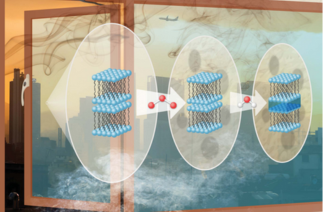Aerosols contribute to ambient air pollution and, via processes such as cloud droplet formation, affect air quality and climate. Organic compounds often play a major role in aerosol composition, varying with time, location, season, and environment. Cooking food releases fatty acids into the air, and cooking emissions contribute around 10% to UK emissions of PM2.5 (aerosols up to two and a half microns wide). These aerosol particles can be deposited onto surfaces such as windows. A thin, layered film of material builds up over time, creating a persistent crust that is only slowly broken down by other chemicals in the atmosphere. In work recently selected as the best 2022 paper in Environmental Science: Atmospheres, a team led by researchers at the University of Birmingham created ultra-thin films, just a few tens of nanometres in thickness, approximating real-world pollution samples. Using X-ray and neutron techniques to study the nanoscale composition of the films and the changes in their surface structures as they aged, the researchers found that the self-organised layered structure can trap toxic pollutants and form a barrier that can prevent their breakdown. They also showed that the film's surface becomes rougher and attracts more water from humidity, an effect with implications for the formation and lifetime of aerosols in the atmosphere.

It will be no surprise to anyone that cooking indoors releases particles that can make your kitchen windows dirty. Organic emissions from cooking include fatty acids, such as oleic acid, which are too stable to break down in the atmosphere. Oleic acid is also abundant in marine aerosol emissions, and the organic materials coating aerosol particles affect urban air quality. Indoors, atmospheric aerosols are deposited on surfaces, such as window glass, forming films.
In laboratory experiments, oleic acid is often used as a proxy, allowing researchers to study reactive organic aerosol systems. As a fatty acid surfactant, oleic acid can decrease the surface tension of a liquid, affecting an aerosol particle's ability to take up water and form a cloud droplet. Like soap, oleic molecules have both water-attracting and water-repelling sections, allowing them to form lyotropic liquid crystals (LLCs). At a relative humidity of around 50%, they can also form layered stacks. These distinct molecular arrangements have different viscosity and diffusivity, both factors affecting the ageing of atmospheric particles.
In this study, the research team created ultra-thin oleic acid-sodium oleate films on solid silicon substrates and subjected them to oxidation and humidity changes that simulate atmospheric ageing. They used a combination of optical microscopy, neutron reflectometry (NR) (at ISIS and ILL) and grazing-incidence small-angle X-ray scattering (GI-SAXS) on Diamond's I22 beamline to study changes in the surface structure of the films as they aged.
NR can probe the structure of interfaces, providing depth-resolved structural information and data on the thickness, roughness and density of each interfacial layer. GI-SAXS is a closely-related surface technique used to probe the surface morphology of materials.
Commonly used to determine the self-assembly and self-organisation of thin films at the nanoscale, GISAXS can measure X-ray scattering over a larger angular range and off-specular scattering (in the y-direction). In this work, it allowed the research team to determine the orientation of the layered stacks.
Dr Nick Terrill is the Principal Beamline Scientist for I22. He says:
This was a challenging experiment to set up, the first of its kind on I22, and involved a close collaboration to develop the sample environment, a humidity chamber that allowed us to do these experiments in situ. Most of the work we do on I22 looks at bulk samples, so it was an exciting development for us to look at the surface of these materials and use I22 to collect high-quality GI-SAXS data.
The study results show that the fatty acids released during cooking form self-organised thin films on surfaces, building up over time into a coating that only breaks down very slowly. As it ages, the coating becomes rougher, attracting more moisture from the air. The crust can trap other toxic pollutants, effectively protecting them from being broken down and removed.
As Dr Christian Pfrang, an atmospheric scientist from the University of Birmingham, explains:
The fatty acids in these films are not, by themselves, particularly harmful – but because they are not being broken down, they are effectively protecting any other pollutants that might be trapped underneath.
Identifying the conditions under which these persistent films form will also improve our understanding of aerosol behaviour in the atmosphere, feeding into the models scientists use to investigate air quality, cloud formation and climate.
To find out more about the I22 beamline or discuss potential applications, please contact Principal Beamline Scientist Nick Terrill: [email protected].
Milsom A et al. The evolution of surface structure during simulated atmospheric ageing of nano-scale coatings of an organic surfactant aerosol proxy. Environmental Science: Atmospheres 2.5 (2022): 964-977. DOI:10.1039/D2EA00011C.
Diamond Light Source is the UK's national synchrotron science facility, located at the Harwell Science and Innovation Campus in Oxfordshire.
Copyright © 2022 Diamond Light Source
Diamond Light Source Ltd
Diamond House
Harwell Science & Innovation Campus
Didcot
Oxfordshire
OX11 0DE
Diamond Light Source® and the Diamond logo are registered trademarks of Diamond Light Source Ltd
Registered in England and Wales at Diamond House, Harwell Science and Innovation Campus, Didcot, Oxfordshire, OX11 0DE, United Kingdom. Company number: 4375679. VAT number: 287 461 957. Economic Operators Registration and Identification (EORI) number: GB287461957003.